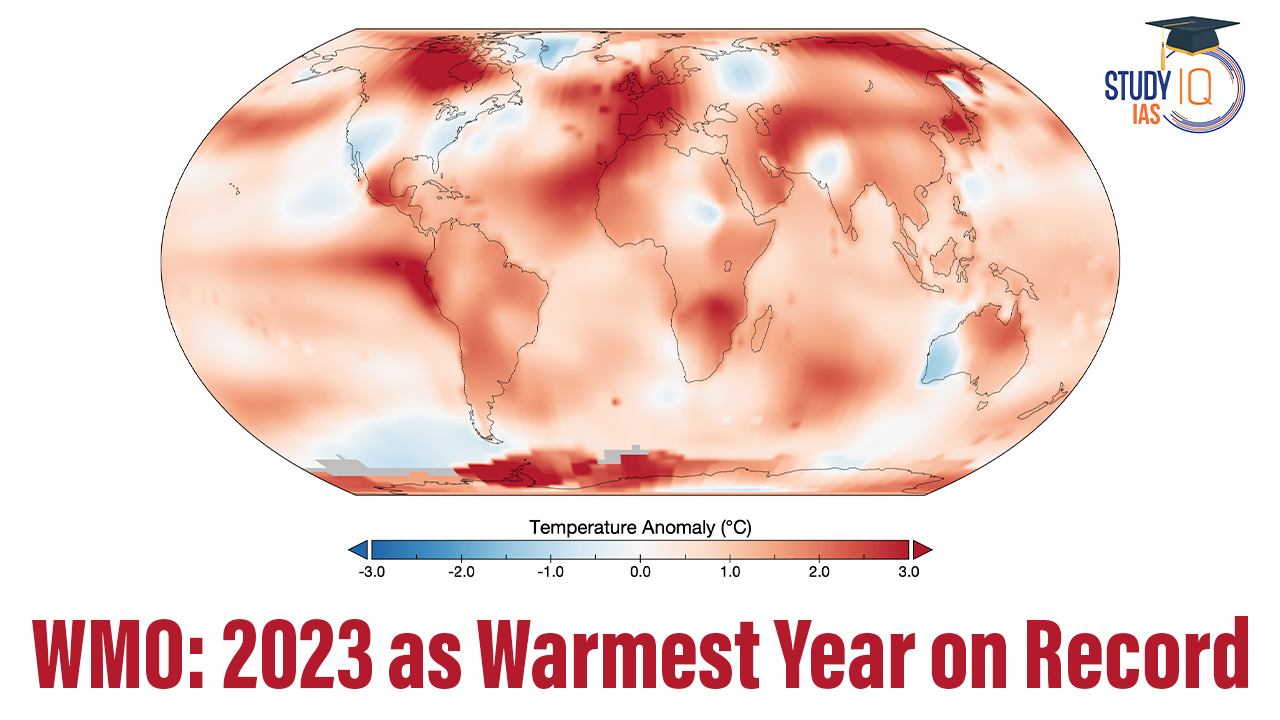Table of Contents
Context: The World Meteorological Organization (WMO) declared 2023 as the warmest year on record, with the years from 2014 to 2023 being the warmest decade.
WMO Annual State Of Climate Report Highlights
- Global mean surface temperatures in 2023 were 45 degrees Celsius higher than the pre-industrial average from the 1850-1900 period, indicating a significant 1.29 degrees Celsius increase from pre-industrial times.
- Average global temperatures for the decade spanning 2014-2023 exceeded the pre-industrial average by 1.2 degrees Celsius.
Green Houses Concentration
- Carbon dioxide concentrations in 2022 were at 9 parts per million, which is 150% higher than pre-industrial levels of 278 parts per million.
- Methane concentrations reached 1,923 parts per billion, a significant rise from pre-industrial levels of 764 parts per billion.
- Nitrous oxide levels were measured at 8 parts per billion, surpassing the pre-industrial benchmark of 270 parts per billion.
- These greenhouse gases, which accumulate in the atmosphere and are not readily absorbed by the oceans, exacerbate global warming and contribute to ocean acidification and rising sea levels.
Ocean Heat and Sea-Levels
- The ocean heat content in 2023 was notably high, reaching a 65-year high and thus amplifying the warming trend.
- The Mediterranean Sea and the Atlantic Ocean experienced unusually warm conditions, while the Pacific Ocean was subject to a La Niña event.
- Land areas in the Arctic and Antarctic recorded warmer-than-average temperatures, with the Antarctic suffering significant ice losses.
- Approximately 70% of the Earth’s surface is covered by water; the rise in sea surface temperatures is indicative of overall global warming.
Extreme Weather
- Extreme weather conditions including heat waves, wildfires, and floods have led to significant socio-economic challenges.
- Parts of Hawaii, Canada, and Europe were hit by wildfires, resulting in fatalities, destruction of property, and extensive air pollution.
- Triggered by the Mediterranean cyclone Daniel, nations such as Greece, Bulgaria, Turkey, and Libya experienced devastating floods, with Libya suffering a high death toll.
- Tropical cyclone Freddy emerged as one of the longest-lasting tropical cyclones on record.
- The Horn of Africa, previously dry due to a prolonged drought, faced severe flooding later in the year due to heavy rains influenced by El Niño and a positive Indian Ocean Dipole.
Economic and Environmental Impact
- Hurricane Otis’ Cost: Hurricane Otis was the costliest event of 2023, escalating to a category 5 hurricane and striking the Pacific coast of Mexico.
- Increasing Marine Heatwaves: Marine heatwaves have grown more common, severe, and prolonged, often triggered by El Niño events in the eastern Tropical Pacific.
Concerns for Vulnerable Communities
- Food and Security Risks: Food insecurity and the displacement of populations were pressing issues in 2023, with climate-related hazards intensifying these problems globally.
- Financing Gap in Climate Adaptation: The shortfall in climate adaptation funding is expanding, notably lacking the annual $212 billion estimated necessary for developing countries up to 2030.
Future Steps for Climate Change Mitigation and Adaptation
- Strengthening NMHS: Enhancing support for National Meteorological and Hydrological Services is critical for providing vital weather and water-related information.
- Science-Based NDCs: Nationally Determined Contributions should be informed by scientific research to effectively reduce greenhouse gas emissions and move towards renewable energy.
- Climate Finance at COP-29: At the upcoming COP-29 in Baku, Azerbaijan, securing sufficient funds is essential to back national climate strategies, including investment in mitigation, adaptation, technology shifts, capacity building, and enhancing resilience, especially for developing nations.
We’re now on WhatsApp. Click to Join
World Meteorological Organisation (WMO)
| Aspect | Details |
| Mission |
|
| History |
|
| Structure |
|
| Major Programs |
|
| Membership | Currently consists of 187 member countries. |
| Headquarters | Geneva, Switzerland. |


 Indus Water Treaty 1960 Suspended by Ind...
Indus Water Treaty 1960 Suspended by Ind...
 5 Years of SVAMITVA Scheme and Its Benef...
5 Years of SVAMITVA Scheme and Its Benef...
 Places in News for UPSC 2025 for Prelims...
Places in News for UPSC 2025 for Prelims...





















